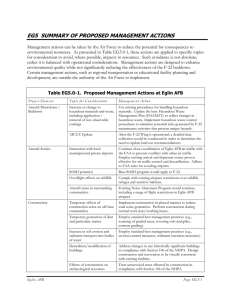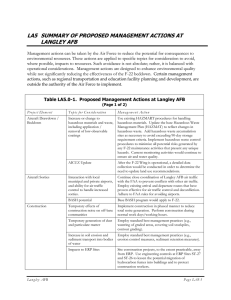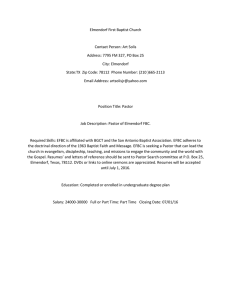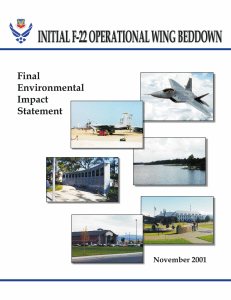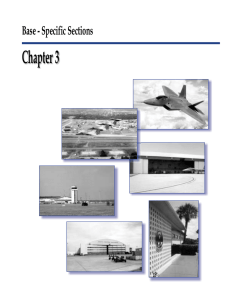EL2 ELMENDORF AFB ALTERNATIVE
advertisement
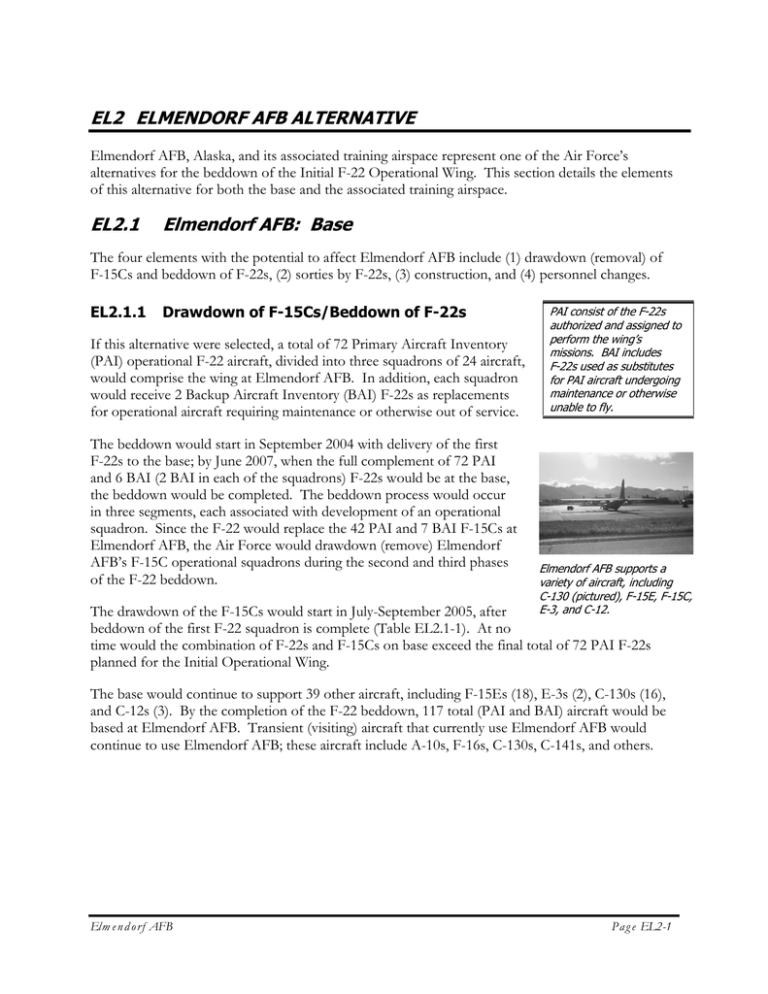
EL2 ELMENDORF AFB ALTERNATIVE Elmendorf AFB, Alaska, and its associated training airspace represent one of the Air Force’s alternatives for the beddown of the Initial F-22 Operational Wing. This section details the elements of this alternative for both the base and the associated training airspace. EL2.1 Elmendorf AFB: Base The four elements with the potential to affect Elmendorf AFB include (1) drawdown (removal) of F-15Cs and beddown of F-22s, (2) sorties by F-22s, (3) construction, and (4) personnel changes. EL2.1.1 Drawdown of F-15Cs/Beddown of F-22s If this alternative were selected, a total of 72 Primary Aircraft Inventory (PAI) operational F-22 aircraft, divided into three squadrons of 24 aircraft, would comprise the wing at Elmendorf AFB. In addition, each squadron would receive 2 Backup Aircraft Inventory (BAI) F-22s as replacements for operational aircraft requiring maintenance or otherwise out of service. The beddown would start in September 2004 with delivery of the first F-22s to the base; by June 2007, when the full complement of 72 PAI and 6 BAI (2 BAI in each of the squadrons) F-22s would be at the base, the beddown would be completed. The beddown process would occur in three segments, each associated with development of an operational squadron. Since the F-22 would replace the 42 PAI and 7 BAI F-15Cs at Elmendorf AFB, the Air Force would drawdown (remove) Elmendorf AFB’s F-15C operational squadrons during the second and third phases of the F-22 beddown. PAI consist of the F-22s authorized and assigned to perform the wing’s missions. BAI includes F-22s used as substitutes for PAI aircraft undergoing maintenance or otherwise unable to fly. Elmendorf AFB supports a variety of aircraft, including C-130 (pictured), F-15E, F-15C, E-3, and C-12. The drawdown of the F-15Cs would start in July-September 2005, after beddown of the first F-22 squadron is complete (Table EL2.1-1). At no time would the combination of F-22s and F-15Cs on base exceed the final total of 72 PAI F-22s planned for the Initial Operational Wing. The base would continue to support 39 other aircraft, including F-15Es (18), E-3s (2), C-130s (16), and C-12s (3). By the completion of the F-22 beddown, 117 total (PAI and BAI) aircraft would be based at Elmendorf AFB. Transient (visiting) aircraft that currently use Elmendorf AFB would continue to use Elmendorf AFB; these aircraft include A-10s, F-16s, C-130s, C-141s, and others. Elmendorf AFB Page EL2-1 Initial F-22 Operational Wing Beddown Draft EIS Table EL2.1-1. Proposed F-22 Beddown and F-15C Drawdown Schedule: Elmendorf AFB Year Baseline 2004 2005 2006 2007 EL2.1.2 Based F-15C PAI Aircraft 42 42 34 8 0 Based F-22 PAI Aircraft 0 7 32 58 72 Total PAI Aircraft 42 49 66 66 72 Sorties Like existing F-15C squadrons at Elmendorf AFB, the operational F-22 squadrons would be integrated into the Air Force’s Expeditionary Air Force (EAF) Construct. The EAF Construct grew out of the need for the United States to deploy forces worldwide despite the reduction in United States overseas basing and personnel. Under the EAF, the Air Force has divided its forces into 10 Aerospace Expeditionary Forces (AEFs) and 2 Aerospace Expeditionary Wings (AEWs) to make worldwide deployments more predictable and manageable. An AEF is a “package” (group of different types of aircraft with a mixture of capabilities suited to the tasking) deployed to overseas locations for about 90 days. These AEFs consist of wings or squadrons from multiple United States bases that operate as a unit or are integrated with other forces overseas. Pre- and/or postdeployment training, at locations other than a “home” base, also occurs for about another 30 days out of the year. Squadrons or wings at the bases are rotated into the AEF program on a 15-month cycle. Elmendorf AFB’s F-15C squadrons are part of the AEF program. The Air Force anticipates that by completion of the beddown, the Initial F-22 Operational Wing would fly 11,187 sorties per year from Elmendorf AFB. Additionally, the Air Force would continue occasional use of the forward operating locations, Galena and King Salmon, at the same levels currently used by the F-15C. Based on projected requirements and deployment patterns under the AEF program, the F-22 Operational Wing would fly an additional 5,760 sorties at overseas airfields during deployments or at other locations for exercises or in preparation for deployments. On average, each squadron (24 PAI aircraft) would be deployed for 120 days per year (90 days AEF and 30 days pre- or post-AEF training); this equates to a single squadron being deployed all year. In addition, each squadron would participate in training exercises and operate out of another United States or overseas base for an average of one week per year, flying another 333 (or 111 sorties per squadron) sorties at remote locations other than Elmendorf AFB. Due to seasonal constraints in Alaska (e.g., long daylight hours in summer), F-15Cs from Elmendorf AFB occasionally deploy to southern bases to meet training requirements. Some of these sorties would involve ordnance delivery training or missile firing at approved A sortie is the flight of a single aircraft from ranges such as the Nellis Range Complex in Nevada, Utah Test and takeoff to landing. Training Range, or Eglin AFB’s over-water ranges in the Gulf of Mexico. Page EL2-2 Elmendorf AFB Initial F-22 Operational Wing Beddown Draft EIS The 11,187 F-22 sorties at Elmendorf AFB would represent an increase of 5,139 annual sorties over total baseline levels (Table EL2.1-2). This 26 percent increase in total sorties would result from two factors: 30 more PAI aircraft (72 F-22 aircraft versus 42 F-15Cs) and the increased sortie rate of F-22s (20 sorties per aircraft per month) as compared to the F-15Cs (18 sorties per aircraft per month). Beddown of the F-22s at Elmendorf AFB would result in a 26 percent increase in sorties from current conditions. Table EL2.1-2. Comparison of Baseline F-15C and Projected F-22 Annual Sorties Baseline Sorties Projected Sorties F-15C 6,048 F-22 11,187 Total All Aircraft1 20,025 Total All Aircraft1 25,164 Note: 1. Includes 13,977 sorties by other based and transient aircraft. At completion of the beddown, the F-22s would perform approximately 44 percent of all sorties at the base. In comparison, the F-15Cs currently account for 30 percent of total sorties. Other based and transient aircraft perform 70 and 56 percent of the sorties under baseline and projected scenarios, respectively. The F-22s would employ similar departure and landing procedures currently used by the F-15Cs at the base. However, the F-22’s power would allow it to accelerate more quickly to climb speed and reduce power sooner past the departure end of the runway. In contrast, the F-15Cs maintain higher power settings throughout their climb. Overall, this capability of the F-22 would result in lower noise exposure in the airfield environment as the aircraft takes off. F-22 operations would adhere to existing restrictions, avoidance procedures, and the quiet-hours program at Elmendorf AFB. Due to its location in Alaska, Elmendorf AFB is subject to substantial variations in daylight. The period of daylight is brief in winter and long in the summer. These differences in the duration of daylight influence how F-15Cs at Elmendorf AFB meet requirements for flying after dark. With the lack of darkness in the summer months, aircrews deploy to more southern locations to fulfill after-dark flying requirements. In the winter, with extended hours of darkness, the requirements can be met easily without flying too late in the day. Due to long hours of darkness during the winter months, aircrews operating from Elmendorf AFB can fulfill night-flying requirements without consistently flying during environmental night (after 10:00 pm and before 7:00 am). The F-22 would fly the same percentage (30 percent) of sorties after dark (i.e., about 1 hour after sunset) as required for the F-15Cs under the Air Force’s initiative to increase readiness. Approximately 5 percent (out of the total 30 percent) of the after-dark sorties are expected to occur during environmental night (10:00 pm to 7:00 am), which is identical to the F-15Cs, with the rest expected to occur about 1 hour after sunset. While the percentages of environmental night operations would not change with beddown of operational F-22s, the total annual sorties during this period would increase by 256 or by about 1 per flying day (240 flying days/year). The F-15Cs at Elmendorf AFB use afterburner for takeoff from 5 to 100 percent of the time, depending upon the seasons and factors such as temperature and humidity. The F-22s would use afterburner 5 percent or less of the time to takeoff. Elmendorf AFB Page EL2-3 Initial F-22 Operational Wing Beddown Draft EIS EL2.1.3 Construction Additional infrastructure and facilities would be required to support F-22 operations (Table EL2.1-3). A total of 22 construction, modification, or infrastructure improvement projects would be implemented over the period from 2002 to 2004 (Figure EL2.1-1). Most construction would occur in 2002 and 2003. In total, the construction, modifications, and infrastructure improvements would affect about 30 to 46 acres and cost approximately $150 million to $305.7 million, depending on the option chosen. For purposes of this analysis, the larger option of 46 acres was assumed because it would encompass all the affected area of the smaller option. Affected acres represent the area covered by the construction footprints of the proposed facilities plus the surrounding lands where construction-related clearing and grading would occur. Infrastructure upgrades, such as connecting new facilities to water and power systems, would also add to the affected areas on the base. No construction is expected at the King Salmon or Galena airports which may be used occasionally as forward operating bases. Construction of six 8-bay drive-through facilities, three hangars, and taxiway/apron modifications represent the most substantial construction projects proposed at Elmendorf AFB. These projects account for 47 percent of the affected acres. Construction and modification projects would be located along the flightline and supporting industrial area in the eastern portion of the base (refer to Figure EL2.1-1). EL2.1.4 Personnel Changes Base personnel would increase by 3.3 percent due to the F-22 beddown. Beddown of the Initial F-22 Operational Wing would also require 1,846 personnel to operate and maintain the wing and to provide necessary support services. Fewer personnel, particularly for maintenance, would be needed for the F-22 wing than for an equivalent number of F-15C aircraft. For Elmendorf AFB, the F-22 personnel positions would be drawn from the equivalent positions associated with existing F-15C manpower authorizations. As such, total personnel would increase by 286 because the base currently supports two F-15C squadrons (Table EL2.1-4). The Air Force expects that changes in personnel needed for the beddown would occur in three phases associated with the establishment of the three squadrons (refer to Table 2.1-1), starting in September 2004 and ending by June 2007. EL2.2 Elmendorf AFB: Training Airspace EL2.2.1 Airspace Use As the replacement for the F-15C at Elmendorf AFB, the F-22 would conduct the same missions and training programs as the F-15Cs (refer to Chapter 2). The Air Force expects that the F-22 would use the training airspace associated with Elmendorf AFB in a manner similar to the F-15Cs currently based there. All F-22 flight activities would take place in existing airspace; no airspace modifications would be required for the F-22. Page EL2-4 Elmendorf AFB Initial F-22 Operational Wing Beddown Draft EIS Table EL2.1-3. Proposed Construction and Modification for Elmendorf AFB Year Description Action Affected Area In Acres 2002 Low Observable/Composite Repair Facility Construct 1.95 2002 Fighter Squadron Operations/ Maintenance Hangar Construct 3.4 2002 Flow Through Covered Aircraft Parking Facilities Construct 2.28 2002 Flow Through Covered Aircraft Parking Facilities Construct 2.28 2002 Apron/Taxiway Upgrade NA 2002 Aerospace Ground Equipment Building Construct 1.72 2002 Engine Shop Upgrade 0.37 2002 Armament Shop Construct 0.55 2002 Flight Simulator Building Construct 0.96 2002 Infrastructure Upgrade NA 2003 Fighter Squadron Operations/ Maintenance Hangar Construct 3.42 2003 Flow Through Covered Aircraft Parking Facilities Construct 2.28 2003 Flow Through Covered Aircraft Parking Facilities Construct 2.28 2003 Fuel Truck Fill Stand Construct 0.10 2003 Hangar #5 (Maintenance & Weapon Loading Trainer) Upgrade NA 2003 Vertical Wing Tank Storage Construct 0.66 2003 Training Detachment, (Bldg. 6230) Upgrade 0.10 2004 Fighter Squadron Operations/ Maintenance Hangar Construct 3.42 2004 Flow Through Covered Aircraft Parking Facilities Construct 2.28 2004 Flow Through Covered Aircraft Parking Facilities Construct 2.28 2004 Apron/Taxiway Upgrade 11.02 2002/03/04 Associated Utilities/Infrastructure Construct 4.1 Total ≈46 Elmendorf AFB Page EL2-5 Initial F-22 Operational Wing Beddown Draft EIS Table EL2.1-4. Proposed Personnel Changes: Elmendorf AFB Baseline Personnel F-15C Baseline Personnel Total Projected Personnel F-22 Projected Personnel Total Total Change in Personnel September 2004 – August 2005 September 2005 – June 2006 September 2006 – June 2007 CHANGE PER BEDDOWN PHASE Officer 100 869 169 938 +69 +23 +23 +23 Enlisted 1,417 5,839 1,598 6,020 +181 +61 +60 +60 Civilian 43 1,990 79 1 2,026 +36 1 +12 +12 +12 Total 1,560 8,698 1,846 8,984 +286 +95 +95 +96 Note: 1. Includes 54 contractor personnel Source: Scutter 2000 The affected airspace units for the Elmendorf AFB alternative consist of seven primary Military Operations Areas (MOA) used by the F-15Cs on a continuing basis for routine training and nine secondary MOAs used by the F-15Cs predominantly for major force exercises (MFE). This pattern of activity would apply should the F-22 beddown occur at Elmendorf AFB. Air Traffic Control Assigned Airspace (ATCAA) Primary MOAs receive daily overlie all the primary MOAs and all but two secondary MOAs (Table use by Elmendorf AFB’s EL2.2-1 and Figure EL2.2-1). These ATCAAs may extend up to 50,000 F-15Cs. The F-22s would feet MSL. Chapter 2 provides definitions of MOAs and ATCAAs. The also use them in the same F-15Cs use the primary MOAs (Susitna, Fox, Stony A and B, Naknek 1 way. and 2, and Galena) for 75 percent of all their training sortie-operations and 92 percent of their routine daily training sortie-operations. Elmendorf AFB’s F-15Cs dominate use of the primary MOAs, A sortie-operation is defined accounting for 73 percent of total sortie-operations. After the as one use of a single beddown, the F-22s would fly 78 percent of the sortie-operations in the airspace unit by one aircraft. primary MOAs. Other current and continuing users of the primary MOAs include F-16s and A-10s from Eielson AFB, F-15Es from Elmendorf AFB, and Navy F-14s and F-18s. The Navy aircraft often fly as adversaries against the F-15Cs and F-16s. Elmendorf AFB Page EL2-7 Initial F-22 Operational Wing Beddown Draft EIS Table EL2.2-1. Baseline and Projected Annual Sortie-Operations in Airspace Associated with Elmendorf AFB Floor (feet) Ceiling1 (feet) Baseline F-15C Use Total Baseline Use2 Projected F-22 Use Projected Total Use2 5,000 AGL or 10,000 MSL, whichever is higher 18,000 MSL 541 599 684 742 5,000 AGL 18,000 MSL 3,151 4,346 3,987 5,182 Stony A MOA 100 AGL 18,000 MSL 2,978 3,982 3,769 4,772 Stony B MOA 2,000 AGL 18,000 MSL 1,354 1,546 1,713 1,905 Naknek 1 MOA 3,000 AGL 18,000 MSL 541 953 684 1,096 Naknek 2 MOA 3,000 AGL 18,000 MSL 180 559 228 607 1,000 AGL 18,000 MSL 45 45 57 57 Yukon 1 MOA 100 AGL 18,000 MSL 706 5,961 893 6,148 Yukon 2 MOA 100 AGL 18,000 MSL 425 4,500 538 4,613 Yukon 3 MOA 100 AGL 18,000 MSL 783 2,621 990 2,829 Yukon 4 MOA 100 AGL 18,000 MSL 328 1,961 415 2,048 Yukon 5 MOA5 5,000 AGL 18,000 MSL 265 1,509 335 1,579 Buffalo MOA 300 AGL 7,000 MSL 90 3,339 114 3,363 Birch MOA 500 AGL 5,000 MSL 46 4,541 58 4,553 Eielson MOA 100 AGL 18,000 MSL 235 3,367 297 3,429 Viper MOA 500 AGL 18,000 MSL 0 1,219 0 1,219 Airspace Unit Primary Airspace Susitna MOA Fox MOA 3 Galena MOA Secondary Airspace 4 Note: (mean sea level [MSL]; above ground level [AGL]). 1. ATCAA overlies all MOAs except Buffalo and Birch MOAs. 2. Includes sortie-operations by all other user aircraft. 3. Not used for MFE. 4. Consists of Yukon 3A (100 AGL–10,000 MSL); Yukon 3B (2,000 AGL–18,000 MSL) . 5. Used for MFE only. Secondary MOAs (Yukon 1-5, Buffalo, Birch, and Eielson) are used by the F-15Cs for 24 percent of their total training activity. Although considered a secondary MOA, Viper MOA receives no use by the F-15Cs. The F-15Cs primarily fly in these secondary MOAs during MFEs with aircraft from Eielson AFB (Alaska) and elsewhere. Approximately 82 percent of F-15C sortie-operations performed during MFEs occur in these secondary MOAs, but they accommodate only 8 percent of routine daily sortie-operations by the F-15Cs. Aircraft based at Eielson AFB (F-16s and A-10s) fly most of the sortie-operations in the secondary MOAs. This pattern of airspace use would continue for the F-22s under this alternative. Page EL2-8 Elmendorf AFB Initial F-22 Operational Wing Beddown Draft EIS Figure EL2.2-1 Primary and Secondary Use Airspace Associated with Elmendorf AFB Elmendorf AFB Page EL2-9 Initial F-22 Operational Wing Beddown Draft EIS The F-15Cs also occasionally use forward operating bases at Galena and King Salmon while on alert status. Both could be used by the F-22s in a similar manner. By completion of the beddown in 2007, F-22 sortie-operations would increase above baseline F-15C levels in each of the seven primary MOAs and nine secondary MOAs (except the Viper MOA ) used by the F-22 by approximately 27 percent. Increases in total sortie-operations for the seven primary MOAs would range from 9 percent (Naknek 2 MOA) to 27 percent (Galena MOA). In the three primary MOAs with the most projected F-22 activity (Fox, Stony A, and Stony B), F-22s would account for 77, 79, and 90 percent of total sortie-operations, respectively. F-22 sortie-operations in the other four primary MOAs would range from 38 percent (Naknek 2 MOA) to 100 percent (Galena MOA) of the total sortie-operations. However, the combined increase would represent about 1.5 additional sortie-operations per flying day in all four MOAs (Susitna, Naknek 1/2, Galena). For the secondary MOAs, increases in total sortie-operations would be less, with 0.3 percent (Birch MOA) to 7.9 percent (Yukon 3 MOA). No F-22 activity would occur in the Viper MOA. In each of the eight secondary MOAs projected for use by the F-22s (predominantly for MFEs), the increase in activity would amount to less than one sortie-operation per flying day. These proportions match those by Elmendorf AFB F-15Cs under baseline conditions. Like the F-15C aircraft, the F-22 would fly approximately 90-minute-long sorties, including takeoff, transit to and from the training airspace, training activities, and landing. Depending upon the distance and type of training activity, the F-22 would generally spend an average of 30 minutes in a MOA. In many instances, single sorties involve the use of more than one MOA for routine daily training. For some air-to-air training, two adjacent MOAs (e.g., Yukon 1 and 2) are flown as one to offer large maneuvering areas. On occasion during an MFE, the F-22 may spend up to 90 minutes in one or a set of MOAs. General F-15 and F-22 Altitude Use Altitude (feet) % of Flight Hours: F-15C % of Flight Hours: F-22 >30,000 8 30 10,000-30,000 67 50 5,000-10,000 14 15 2,000-5,000 8 3.75 1,000-2,000 2.75 1 500-1,000 0.25 0.25 Note: F-22s would fly more of the time at higher altitudes than the F-15Cs now flying in the MOAs. The F-22 would fly more of the time at higher altitudes than the F-15Cs (Table EL2.2-2). In the primary MOAs, the F-22s would operate 95 percent of the time above 5,000 feet AGL with 30 percent of the flight time in the ATCAAs above 30,000 feet mean sea level (MSL) (approximately 19,000 to 29,000 above ground level [AGL]). Except for the Stony A and Galena MOAs, the primary MOAs have floors (base altitudes) precluding flight below 2,000 to 5,000 feet AGL (refer to Table EL 2.2-1). In the Galena MOA, flights would remain above 1,000 feet AGL, with the F-22s flying about 5 percent of the time (i.e., less than 10 minutes total over a year) between 1,000 and 5,000 feet AGL. Flights are authorized down to 100 feet AGL in the Stony A MOA, but Air Force procedures require F-15Cs and F-22s to remain above 500 feet AGL. Under baseline conditions, the Elmendorf AFB F-15Cs fly at 500 to 1,000 feet AGL about 4 percent of the time (i.e., about 60 hours total annually). The F-22s would spend far less (0.25 percent) of their flight time (i.e., less than 5 hours total annually) at these altitudes. With the exception of the Yukon 5 MOA with a floor of 5,000 feet AGL, the F-22s would fly 0.25 percent of the time between 500 and 1,000 feet AGL in the secondary MOAs. This would result in Page EL2-10 Elmendorf AFB Initial F-22 Operational Wing Beddown Draft EIS a reduction of total annual flight time at this altitude from approximately 52 hours by the F-15C to 4 hours by the F-22s. Otherwise, the F-22s would use the same altitude profiles as in the primary MOAs. For the primary and secondary MOAs, the F-22 would fly after dark the same percentage of time (30 percent) as the F-15Cs. However, no flights would occur between the hours of 10:00 pm and 7:00 am (i.e., environmental night). These MOAs currently are not operated at these times, and night training can be achieved well before 10:00 pm during the winter months. Environmental Night (10:00 pm to 7:00 am) — when the effects of aircraft noise on people are accentuated. The F-15Cs currently conduct supersonic flight, as would the F-22, within the four primary and seven secondary MOAs where such activity is already authorized (refer to Table EL2.2-2). Due to the mission of the F-22 and the aircraft’s capabilities, the Air Force anticipates that approximately 25 percent of the time spent in air combat maneuvers would involve supersonic flight. From an overall training program perspective, most (>99 percent) supersonic flight would be conducted above 10,000 feet AGL, with 60 percent occurring above 30,000 feet MSL. In comparison, the F-15Cs commonly conduct supersonic flight for about 7.5 percent of the time spent in air combat maneuvers; training, such flights are performed predominantly between 10,000 feet AGL and 30,000 feet MSL. However, the Alaskan airspace provides for different altitude regimes for supersonic flight. In the primary and secondary MOAs, fixed altitude restrictions apply to supersonic flight (refer to Table EL2.2-2). These restrictions ensure that supersonic activity occurs at a minimum of 5,000 feet above the ground. Given the variations in terrain and elevations of the lands under the MOAs, the lower limit for supersonic activity is more commonly greater than 5,000 feet above the ground. Supersonic flight would also be subject to all current seasonal restrictions applicable to the MOAs. The Final Environmental Impact Statement Alaska Military Operations Areas (Air Force 1995) and the Alaska Airspace Handbook (2000) present these restrictions in detail. With the airspace units, especially the secondary MOAs, other military aircraft, such as F-15Es and F-16s, would continue to conduct training involving supersonic flight. The increase in activity by F-22s is not expected to change the amount of supersonic flight by other users. EL2.2.2 Defensive Countermeasures Annual Chaff and Flare Use Chaff Flare F-15C 22,675 12,096 F-22 41,951 22,374 Change +19,276 +10,278 Like the F-15Cs, the F-22 would employ chaff and flares as defensive countermeasures in training. Chaff and flares are the principal defensive mechanisms dispensed by military aircraft to avoid detection or attack by enemy air defense systems. Because of evolving tactics and mission scenarios, the F-22 is expected to use fewer defensive countermeasures (i.e., chaff and flares) per sortie, due to its stealth characteristics. However, because the F-22 is so new, any reduction in chaff and flare use cannot be defined yet. For the purposes of this analysis, it is estimated that the expenditure of chaff and flares by the F-22s would match that of F-15Cs on a per-sortie basis. Elmendorf AFB Page EL2-11 Initial F-22 Operational Wing Beddown Draft EIS Section 2.1-2 in Chapter 2 (the overall description of the proposed action and alternatives) provides details on the use, composition, and characteristics of chaff and flares. Table EL2.2-2. Baseline and Projected Altitude Use in Airspace Associated with Elmendorf AFB Airspace Unit Primary Airspace Susitna MOA Fox MOA Stony A MOA Stony B MOA Naknek 1 MOA Naknek 2 MOA Galena MOA Secondary Airspace Yukon 1 MOA Yukon 2 MOA Yukon 3 MOA Yukon 4 MOA Yukon 5 MOA Buffalo MOA Birch MOA Eielson MOA Viper MOA4 Notes: 1. 2. 3. 4. PERCENT TIME OF AVERAGE SORTIE-OPERATION (FEET) F-15C/F-22 500– 1,000 – 5,000 – 10,000 – >30,000 1,000 5,000 10,000 30,000 Supersonic Authorized NA NA 4/0.25 NA NA NA NA NA NA 16/4.75 16/5 20/5 20/5 20/5 40/20 40/20 20/15 20/15 20/15 20/15 20/15 57/50 57/50 52/50 55/50 60/50 60/50 57/50 3/30 3/30 8/30 5/30 0/30 0/30 3/30 Yes1 Yes2 Yes3 Yes3 No No No 4/0.25 4/0.25 4/0.25 4/0.25 NA 4/0.25 4/0.25 4/0.25 NA 16/4.75 16/4.75 16/4.75 16/4.75 NA 36/4.75 96/99.75 16/4.75 NA 20/15 20/15 20/15 20/15 40/20 60/95 NA 20/15 NA 52/50 52/50 52/50 52/50 52/50 NA NA 52/50 NA 8/30 8/30 8/30 8/30 8/30 NA NA 8/30 NA Yes2 Yes2 Yes2 Yes2 Yes2 No No No No Only for functional check flights. Above 5,000 feet AGL or 12,000 feet MSL, whichever is higher. Above 5,000 feet AGL or 10,000 feet MSL, whichever is higher. Not used by F-15Cs or projected for use by F-22s. Chaff and flares would continue to be used in the primary and secondary MOAs. Chaff use is limited to a total of 90,000 pounds annually over all the airspace (Air Force 1997). Restrictions for flare use are described below. • Flares may only be employed above 5,000 feet AGL from June 1 through September 30 to reduce the potential for fires. • For the remainder of the year, the minimum altitude for flare use is 2,000 feet AGL, well above the safety standards set by the Department of Defense (DoD). Baseline and projected flare and chaff use would adhere to current seasonal and altitude restrictions. Under the Elmendorf AFB alternative, F-22s would use up to 41,951 bundles (about 10,500 pounds) of chaff per year (in 2007 and after) in the MOAs. This level-of-use would represent an increase of 19,276 bundles (about 4,820 pounds) of chaff annually over baseline F-15C use. The amount of Page EL2-12 Elmendorf AFB Initial F-22 Operational Wing Beddown Draft EIS chaff used in each MOA would be proportional to the number of sortie-operations conducted by the F-22s. The F-22 would release up to 22,374 flares per year in the MOAs. This level-of-use would represent an increase of about 10,278 flares annually over baseline F-15C use. The number of flares used in each MOAs would be proportional to the number of sortie-operations conducted by the F-22s. Based on the emphasis on flight at higher altitudes for the F-22, roughly 80 percent of F-22 flare release throughout the MOAs would occur above 10,000 feet AGL, or more than 14 times the safe minimum release altitude (700 feet) required to ensure that flares are completely consumed before reaching the ground. EL2.3 Permits and State Consultation Air quality permits to construct and operate new stationary sources would be required for new or modified sources of regulated pollutants from engine shops, construction and operation of the LowObservability Composite Repair Facility and other structures. A National Pollution Discharge Elimination System (NPDES) Permit would be obtained from the Alaska Department of Environmental Conservation for a land alteration of more than 5 acres. The Alaska Department of Fish and Game would also be consulted regarding any potential discharge into nearby salmon streams. EL2.4 Public and Agency Concerns The EIS process has undergone an extensive 8-month public scoping period, with 33 scoping meetings in five states. The Air Force publicized the scoping meetings by placing twelve meeting notices in local and regional newspapers, sending press releases to area television stations, and faxing public service announcements to twenty-four radio stations. Flyer were also posted in community buildings and businesses in Dillingham, McGrath, Lime Village, Sleetmute, Talkeetna, Circle Hot Springs, Chalkyitsik, Eagle, Fort Yukon, Venetie, Arctic Village, Galena, and King Salmon. In order to ensure maximum opportunity for community dialogue, scoping was conducted in two distinct phases. Two hundred and thirty-one people attended the Phase-One and Phase-Two scoping meetings for Elmendorf AFB. The Phase-One scoping meeting was held in Anchorage, Alaska, on April 6, 2000. The Phase-Two scoping meetings were in September 2000 in Anchorage on the 18th, Dillingham on the 19th, McGrath on the 20th, Sleetmute on the 21st, Talkeetna on the 22nd, Circle Hot Springs on the 25th, Fairbanks on the 26th, Delta Junction on the 27th, Chalkyitsik on the 28th, Eagle and Fort Yukon on the 29th, Venetie and Arctic Village on October 2nd, Galena on October 3rd, Lime Village on October 4th, and King Salmon on November 1st. Twenty written comments were received from the public and agencies prior to close of the scoping period. During the scoping meetings, people were given the opportunity to ask questions and provide comments on the Initial F-22 Operational Wing beddown proposal. Some of the questions include: • Why is Langley AFB the preferred alternative? (see Chapters 1 and 2) • What is the noise comparison between the F-18 and the F-15? (see Table EL3.2-3) Elmendorf AFB Page EL2-13 Initial F-22 Operational Wing Beddown Draft EIS • After Phase One, how many bases will be analyzed in the EIS? (see Chapter 1) • Are these aircraft louder than the other ones or about the same? (see Table EL3.2-3) • Will they need to use afterburners for takeoff? (see section EL2.1.2) • Will Galena and King Salmon be used as auxiliary bases for the F-22? (see section EL2.13) • Will the F-22 use live ordnance? (see section EL2.1.2) • Will the engine emissions information be disseminated to the public? (see section EL3.3) • There was concern about moose hunting under Galena MOA and impacts to fishing under Naknek MOAs. (see section EL3.6) • What is the noise level for this aircraft? Will civilian aircraft be able to see the F-22? How will the aircraft fly in the airspace? (see sections EL3.2 and EL3.1) • Will use of the Stony MOA be the same for the F-22? (see section EL3.1) • How high will the F-22 fly – will it fly higher for training purposes? (see section EL2.2) • Is the Air Force required to stay at certain altitudes over the town? (see section EL3.1) • I don’t think anyone here objects to the Air Force, but we’d like to know what impact the noise will have on us and on wildlife. (see sections EL3.6 and EL3.12) • We have a lot of small aircraft that fly to our small villages when they are doing their training, do they coordinate with civilian authorities before starting training? (see section EL3.1) • In Stony and Galena MOAs, much of the radar is masked, there is a concern about separation of aircraft. (see section EL3.1) • What is low-altitude for the F-22? (see section EL2.2) • Do you know what the additional construction at Elmendorf will be? (see section EL2.1.3) • How noisy will the F-22 be? (see section EL3.2) • What would be the net gain or loss of jobs in Alaska if the F-22 comes to Elmendorf? (see section EL3.13) Page EL2-14 Elmendorf AFB Initial F-22 Operational Wing Beddown Draft EIS • Will the EIS consider putting two squadrons at Elmendorf and one at Eielson? (see Chapter 1 and 2) • Do you have any low-altitude/VFR training routes that the F-22 would use? (see Appendix AO-1) • Will the Galena facility support the F-22? (see sections EL2.1.3 and EL2.2.1) • Would the King Salmon runway have to be lengthened? (the runway would not be lengthened; see section EL2.1.3) • There may need to be a more formalized BASH program here at King Salmon. (see section EL3.4) • In the spring, the Naknek is one of the first drainages to open up and seems to be used as a staging area in the spring by passerines. What is the effect of the aircraft on the birds that stage in this area? (infrequent use of King Salmon; see section EL3.6) Elmendorf AFB Page EL2-15 Initial F-22 Operational Wing Beddown Draft EIS Page EL2-16 Elmendorf AFB
